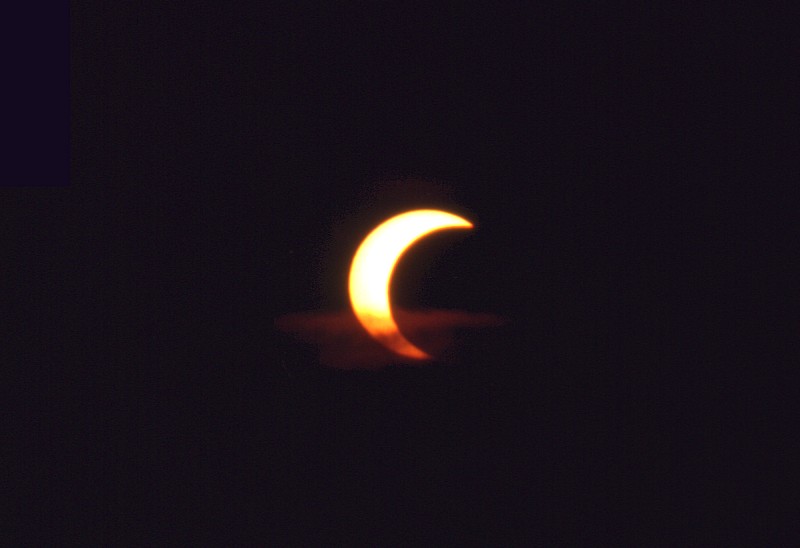A solar eclipse occurs when the Moon passes between Earth and the Sun, thereby totally or partially obscuring Earth's view of the Sun. This configuration can only occur during a new moon, when the Sun and Moon are in conjunction as seen from the Earth.
Total solar eclipses are very rare events for any given place on Earth because totality is only seen where the Moon's umbra touches the Earth's surface. A total solar eclipse is a spectacular natural phenomenon and many people consider travel to remote locations in order to observe one. The 1999 total eclipse in Europe, possibly the most-watched eclipse in human history, helped to increase public awareness of the phenomenon.
There are four types of solar eclipses:
* A total eclipse occurs when the Sun is completely obscured by the Moon. The intensely bright disk of the Sun is replaced by the dark silhouette of the Moon, and the much fainter corona is visible. During any one eclipse, totality is visible only from at most a narrow track on the surface of the Earth.
* An annular eclipse occurs when the Sun and Moon are exactly in line, but the apparent size of the Moon is smaller than that of the Sun. Hence the Sun appears as a very bright ring, or annulus, surrounding the outline of the Moon.
* A hybrid eclipse is intermediate between a total and annular eclipse. At some points on the surface of the Earth it is visible as a total eclipse, whereas at others it is annular. Hybrid eclipses are rather rare.
* A partial eclipse occurs when the Sun and Moon are not exactly in line, and the Moon only partially obscures the Sun. This phenomenon can usually be seen from a large part of the Earth outside of the track of an annular or total eclipse. However, some eclipses can only be seen as a partial eclipse, because the umbra never intersects the Earth's surface.
NEVER LOOK THROUGH A TELESCOPE OR BINOCULARS TO POINT AT THE SUN. Partial or total irreversible blindness result.
This picture have been taken using a special type of filter designed to be safe observing the Sun.
 Un eclipse solar ocurre cuando la Luna pasa entre la Tierra y el Sol, oscureciendo por lo tanto, total o parcialmente la luz del Sol sobre la Tierra. Esta configuración sólo puede ocurrir durante la luna nueva, cuando el Sol y la Luna están en conjunción, visto desde la Tierra.
Los eclipses solares totales son eventos muy raros para un lugar determinado en la Tierra porque la totalidad sólo se ve cuando la sombra de la Luna toca la superficie de la Tierra. Un eclipse total de Sol es un fenómeno natural espectacular y muchas personas consideran viajar a lugares remotos con el fin de observar uno. El eclipse total de 1999 en Europa, posiblemente el eclipse más visto en la historia humana, ha ayudado a aumentar la conciencia pública sobre el fenómeno.
Hay cuatro tipos de eclipses solares:
* Un eclipse total ocurre cuando el Sol está completamente oculto por la Luna. El disco intensamente brillante del sol es reemplazado por la silueta oscura de la Luna, y la tenue corona es mucho más visible. La totalidad es visible sólo en una estrecha banda en la superficie de la Tierra.
* Un eclipse anular se produce cuando el Sol y la Luna están exactamente en línea, pero el tamaño aparente de la Luna es más pequeña que la del sol. Por lo tanto el Sol aparece como un anillo muy brillante, o anillo, que rodea el contorno de la luna.
* Un eclipse híbrido es intermedio entre un eclipse total y anular. En algunos puntos de la superficie de la Tierra es visible como un eclipse total, mientras que en otros es anular. Eclipses híbridos son más bien raros.
* Un eclipse parcial ocurre cuando el Sol y la Luna no están exactamente en línea, y la luna sólo oculta parcialmente el sol. Este fenómeno se puede ver generalmente en una gran parte de la tierra fuera de la banda de un eclipse anular o total. Sin embargo, algunos eclipses sólo puede ser visto como un eclipse parcial, porque nunca la sombra cruza la superficie de la Tierra.
NUNCA
OBSERVES A TRAVÉS DE UN TELESCOPIO O BINOCULARES APUNTANDO AL SOL. El
resultado será una ceguera irreversible total o parcial.
Esta imagen ha sido capturada usando un tipo especial de filtro diseñado para ser seguro observando el Sol.
|
|

